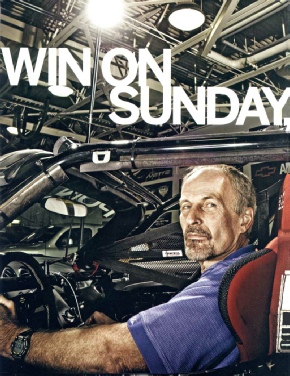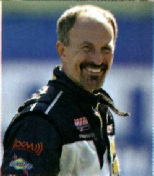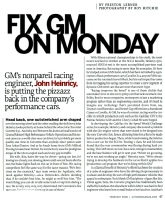

FIX GM ON MONDAY
GM's nonpareil racing engineer, John Heinricy, is putting the pizzazz back in the company’s performance cars.
BY PRESTON LERNER
PHOTOGRAPHY BY ROY RITCHIE
Head back, one outstretched arm draped over the steering wheel and the other cradling the shift lever, John Heimicy looks perfectly at home behind the wheel of a Chevrolet Corvette Z51. And why not? Between his duties as head honcho of General Motors’ High Performance Vehicle Operations and his second career as a world-class race car driver, he’s probably got more quality seat time in Corvettes than anybody since patron saint Zora Arkus-Duntov. And as he heads home from GM’s Milford Proving Ground near Detroit, he instinctively uses the prodigious torque of the LS2 to exploit each and every gap in traffic.
His wife, Rita, hates the way he drives-going too fast, following too closely, not slowing down until several beats after he sees the brake lights flash on the car in front of him. His racing competitors feel the same way for the same reasons, “He’s ferocious on the racetrack,” says team owner Joe Aquilante, who raced against Heinricy-a.k.a. Heinrocket before deciding that, if he couldn’t beat him, he might as well hire him. “The worst thing you can do is talk some trash or tap him during a race. He is very, very, very, very determined. He’s wrecked a few race cars, but he’s never given up in one of them.”
With fifteen national championships to his credit, the most recent notched in October at the SCCA Runoffs, Heinricy (pronounced HINE-ri-see) is the most accomplished part-time road racer in America But racing is more than his avocation. It’s how he’s helped restore GM’s luster, which had been tarnished by a generation of faux performance cars. (Cavalier Z24, anyone?) His successes on the racetrack haven’t hurt, but his real impact has come from leveraging his racing expertise to create a new segment of dynamic GM street cars that are more than mere hype.
“Racing improves the breed” is one of those cliches that automakers love to trot out to pimp cars that lack racetrack credibility. But for most companies, motorsports is just a marketing program rather than an engineering exercise, and it’s hard to imagine any technology that’s percolated down from, say, Toyota’s vast Formula I and Nextel Cup efforts into a humdrum Camry or Corolla. At GM, by way of contrast, racing was the crucible in which production cars such as the Cadillac CTS-V, the Pontiac Solstice GXP, and the Chevy Cobalt SS were forged.
In developing the Cadillac for the Speed World Challenge series, for example, Heinricy and company discovered a problem with the LS7 engine valves that were slated to be dropped into the new Corvette Zo6, hence allowing time for a fix to be made before production began. Then, while-transforming the Solstice into a race car for the SCCA’s Touring 2 class, he and his team found that the rear crossmember was flexing during hard cornering. The GXP street car now has a new, stronger crossmember, and the base Solstice will get it next year. “When we go racing, we’re not just working an angle,” Heinricy says. “We’re always trying to develop the hardware in the car so that it applies to a [production-car] program that we’re doing within GM.”
A collateral benefit of Heimicy’s efforts has been the creation of a cadre of engineers who have the driving chops necessary to evaluate and develop the sort of high-performance vehicles that appeal to enthusiasts. You’d think GM had plenty of guys like this. Think again. Sure, the Corvette program has traditionally been staffed by hotshoes. But elsewhere within GM, it was hard to find engineers who knew how to trail-brake or heel-and-toe. And that’s a problem when you’re developing cars designed for, well, trail-braking and heel-and-toeing. So, six years ago, Heimicy launched a rigorous program to train engineers. Before being allowed to test on the Milford Road Course, they first must pass a high-performance driving class. But to test on the most daunting racetracks-including the Niirburgring-they also have to demonstrate the ability to consistently turn laps within two percent of a bogey time that Heinricy has set in a Zo6. “His legacy,” says Don Knowles, a fellow racer (and multiple national champion) who consults for GM as a driving instructor, “will be a core group of midlevel engineers who understand what a good car is. It doesn’t matter whether they end up working on hybrids or pickups or whatever. They will have a ripple effect on the company.”
“Heinricy’s legacy will be a group of engineers who understand what a good car is.”
HEINROCKET
HIGHLIGHTS:
1989: IMSA Firestone
Firehawk Endurance, Grand Sport championship (IROC-Z)
 1989: SCCA Escort Endurance, SSGT championship (IROC-Z)
1989: SCCA Escort Endurance, SSGT championship (IROC-Z)
1993: SCCA Runoffs, GTl championship (Corvette)

1996-97: IMSA Speedvision Cup, Grand Sport championships (Firebird)
2002-05: SCCA Runoffs,
Touring 1 championships
(Corvette)
2003-06:
SCCA Runoffs, American Sedan championships
(Firebird, and Camaro)
2007: SCCA Runoffs,
Touring 3 championship (Cobalt SS)











Low-key and buttoned-down, a sixty-year-old Midwesterner wearing corporate attire and toeing the company line, Heinricy doesn’t look or act like a prophet. But appearances to the contrary, he’s the kind of impassioned car guy who feeds on car specs and bleeds 10W-40. Although he grew up milking cows on a farm in South Dakota, he was driving by the time he was eight, tearing up the backyard in a ‘55 Pontiac. When he was eleven, he took apart a Briggs & Stratton engine-“it was so rusted that I had to soak it in diesel fuel for a couple of weeks”-and put it back together to use in a motorized bicycle. After his mother persuaded him to aim higher than his original goal of becoming a car mechanic, he earned a degree in mechanical engineering and signed on at Chevrolet as a test engineer.
While working at Milford, he learned that his forte was ride and handling. On his own, he developed a performance package for the Chevy Citation, which went on to dominate its class in SCCA club racing. This led to a stint on the new C4 Corvette and, later, a GM-sponsored return to school to get an MBA. This put Heinricy on the fast track to a position as a corporate executive. But an experience providing trackside support for a Chevy Camaro running in the twenty-four-hour enduro at Nelson Ledges caused him to jump the rails and belatedly infected him with a serious case of the racing jones.
Heinricy ran his first race, in a rented Citation, when he was thirty-six. Before long, he was racing in nearly two dozen pro events per year while working full-time at GM. Aside from testing and a handful of one-off drives in more exoticequipment, he’s spent his entire career in production-based GM race cars, and he’s as good as it gets in raunchy, rear-wheel-drive iron-F-body Camaros and Pontiac Firebirds and, most notably, hairy-chested C4 and C5 Corvettes.
“It starts with his encyclopedic knowledge of the car he’s racing-every bolt size, every thread pitch, every durometer reading,” Knowles says. “You have to beat John in terms of car prep, which is hard. You have to beat him in terms of car setup, which is also hard. You have to beat him in terms of driving ability, and that’s hard, too. String it all together and you’ve got a formidable opponent. When you beat him, it’s a very special treat.”
Although Heinricy doesn’t strut around the paddock telling everybody how great he is, he’s convinced that he stacks up well with even the most rarefied competition. As he puts it: ‘You quickly realize that there aren’t any gods in racing.” Over the years, he’s held his own against team-mates such as Max Angelelli, Ron Fellows, Boris Said, and Scott Sharp. As recently as 2005, during a guest appearance in a World Challenge Cadillac at Mid-Ohio, he outran team drivers Max Papis and Andy Pilgrim en route to a second-place finish.
Although Heinricy clearly had enough talent to turn pro, he started racing too late to get a call from a premier team. Plus, he had the kind of day job that most engineers would kill for. Two cars he keeps under wraps in his two-story garage-yep, he designed it on a steep hill to accommodate split levels-mark the two poles of his career. On the left is the Camaro IROC-Z he co-drove with Knowles to his first national championship in 1989. On the right is a Corvette Grand Sport. Serial number 0001. “It’s a beauty, isn’t it?” he says as he pulls off the cover and admires the two-tone, limited-edition C4 he helped conceptualize.
Heinricy suspects that his career progress was slowed by his passion for racing and Corvettes, and he’s done some time in prosaic passenger-car programs. But when GM created HPVO in 2002 as an analog to performance divisions such as Fords SVT, Chrysler’s SRT, and BMW’s M, Heinricy was the obvious choice to run it. While developing cars for racing, he and his 150 employees typically work on five production cars and proposals for five more.
“I love my job,” Heinricy says. “I really enjoy developing cars to be fast. But I really enjoy racing, too. In fact, I enjoy it more now than I ever have. Still, it would be hard for me to be as satisfied racing full-time as I am with what I do today, which is a mixture of the two.”
He throws the car cover back over the Grand Sport and closes the garage door, a dream engineer with a dream job.


Joe Aquilante, president (610) 482-0141 JFAPhoenix32@aol.com
© Phoenix Performance, LLC
(for best results, set pop-ups & scripting allowed) • website design by Hi-Per Products Web Services



 1989: SCCA Escort Endurance, SSGT championship (IROC-
1989: SCCA Escort Endurance, SSGT championship (IROC-





















